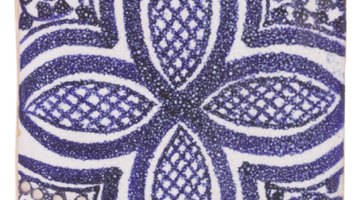How to Remove Polyurethane From Ceramic Tile
Interior decorators and homeowners choose ceramic tile for its durability and aesthetic value. Ceramic tiles are available in a myriad of textures, colors, patterns, shapes and sizes. Ceramic tiles integrate well into a variety of design themes.

Polyurethane is a protective coating and sealant that bonds to a surface to shield it from damage. Removing polyurethane from ceramic tile requires the use of the correct solvent.
Things You Will Need
- Chemical-approved respirator
- Rubber gloves
- Chemical-approved safety goggles
- Rag
- Paint thinner, white spirits, acetone or chemical solvent
- Plastic scraper
Tip
Do not use metal scrapers or abrasive pads when removing polyurethane, as these may cause scratches or gouges on the tile surface.
Warning
Keep solvents away from open flames because they are highly flammable.
-
Wear a chemical-approved respirator, rubber gloves and chemical-approved safety goggles.
-
Dip a clean, lint-free rag into one of the following solvents: paint thinner, white spirits or acetone. Polyurethane solvents are also available in paint stores. All the solvents are equally effective. Commercially available polyurethane solvents come in varieties that are environmentally friendly and non-flammable, whereas paint thinner, white spirits and acetone are all toxic and flammable.
-
Rub the rag over the polyurethane to soften it. Rub the polyurethane from the outer edge of the tile toward the middle to create a pliable pool on the tile. It will take a considerable amount of solvent and rubbing to break down the polymers in the polyurethane. For large areas requiring polyurethane removal, pour the solvent directly onto the tile and allow it to remain on the surface until the polyurethane turns to a gummy consistency. Some solvents evaporate very quickly and require multiple applications.
-
Remove the sticky polyurethane from the surface with a plastic scraper.
-
Wash the ceramic tile with a mild detergent and flush thoroughly with plain water.
The Drip Cap
- Interior decorators and homeowners choose ceramic tile for its durability and aesthetic value.
- Ceramic tiles integrate well into a variety of design themes.
- Dip a clean, lint-free rag into one of the following solvents: paint thinner, white spirits or acetone.
- For large areas requiring polyurethane removal, pour the solvent directly onto the tile and allow it to remain on the surface until the polyurethane turns to a gummy consistency.
References
- "New Fix-It-Yourself Manual: How to Repair, Clean, and Maintain Anything and Everything In and Around Your Home"; Reader's Digest Editors; 1996
- "Handbook of Adhesives and Sealants"; Edward M. Petrie; 2006
Writer Bio
Sal Marco began writing professionally in 2009. He has written many online home improvement articles based on his more than 20 years of experience in the home improvement and building industries. He has worked as both part of a team and as a site supervisor. Marco has a Bachelor of Science in management science from Kean University.
Photo Credits
- PhotoObjects.net/PhotoObjects.net/Getty Images
- PhotoObjects.net/PhotoObjects.net/Getty Images
More Articles



